

Vernon E. Londagin III - NanoJapan 2014
University of Tulsa
Major: Physics & Mathematics
Class Standing: Sophomore
Anticipated Graduation: May 2016
NanoJapan Research Lab: Ultra Broadband Signal Processing, Prof. Taiichi Otsuji, Tohoku University
NanoJapan Research Project: ![]()
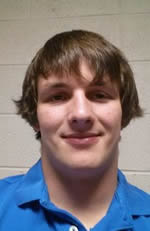
Why NanoJapan?
The NanoJapan Program represents a fundamental stepping stone that bridges the gap between the worlds of undergraduate study and academia. It provides intelligent, motivated students with an introduction to all of the necessary tools and skills required to flourish as a researcher. This program allows students to work alongside international researchers, who are distinguished in their respective fields, in a country that is at the forefront of scientific and technological innovation. NanoJapan helps students discover new and innovative ways of thinking and problem solving, forcing them to adapt to and overcome the challenges presented to them in an actual, real-world research environment. More than that, however, the NanoJapan program stresses the issue of cross-cultural collaboration, which is necessary for success in the scientific community, as science truly is a global pursuit.
I chose to apply to NanoJapan for all of these reasons. Throughout the course of the program I hope to accomplish many things. I hope to develop and enhance my knowledge of physics through the emerging field of nanotechnology. I hope to gain skills and knowledge that I can use throughout the rest of my undergraduate years, and also throughout my graduate years into my professional career. Most importantly, however, I hope to forge bonds of friendship with my peers, instructors, and fellow researchers that will last for the rest of my life. I am excited for the opportunity to experience an entirely new culture and become a part of this great big world. I have no doubt that by the end of this adventure I will have learned a tremendous amount about nanotechnology, the Japanese culture, and myself. I hope to acquire skills, friendships, and memories that will last me a lifetime.
My goals for this summer are to:
Upon arriving in Tokyo I quickly fell in love with everything that I saw. It was like everything I had ever imagined it would be and much, much more. Coming from a very small town in Oklahoma, I had never experienced anything quite like it. Immediately I saw huge streets of skyscrapers standing side by side, covered with advertisements and different Japanese characters. The city of Tokyo never ends! As far as we could see (even from Tokyo tower) the city stretched out forever in all directions! Every which way I looked I was amazed by what I saw, the architecture, vehicles, street signs, and the people. There was no doubt that I was, in fact, in Tokyo.
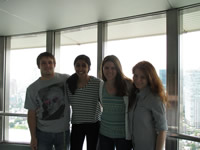
Ramya, Lauren, Nicole, and I from the top floor inside Tokyo Tower
For me the first week consisted of a lot of exploring! I was so excited to be in such a new and unique place that I took literally every free moment we had to go exploring in Tokyo. In just the first week I had explored (and been lost in) Azubu-juban, where we are staying, Harajuku, Shibuya, Shinjuku, Akihabara, Asakusa, and Roppongi. Every one of these places was incredible. There were so many different types of people and things to see and do while we were there. On a couple occasions we couldn’t bring ourselves to leave until almost midnight or so (almost missing the last train). Also, we went and adventured around Kamakura, with one of the KIP students named Toshi, which was amazing. It was really unique to see so many different temples and shrines and to truly appreciate the Japanese culture from this standpoint. Each of these places exhibited several things that I had anticipated about Japan; however, I could have never fully guessed what it may have been like without actually seeing it in person.
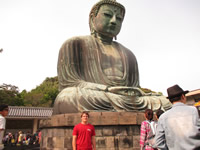
Visiting the Big Buddha statue, just outside of Kamakura
For me it was quite difficult to delve into the Japanese culture at first, especially regarding the cuisine. However, after convincing myself to try it first and then ask questions later, I have found that Japan has some of the best food I have ever eaten. Once I learned to overcome my preconceived notions, a whole new world was opened up to me! Initially I had absolutely hated fish and seafood of all kinds, but recently I have tried a lot of different dishes with seafood and have found that I quite enjoyed them!
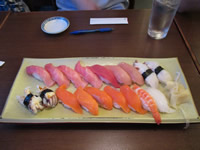
Trying sushi for the first time!!!
There are quite a few things about Japan that have really stuck out to me since my arrival. Tokyo is one of the cleanest cities I have ever been in, despite the lack of trashcans. I still have yet to see any trash on any of the sidewalks, no matter where you go. Also, the people here are very proud of their work. All of the employees are always very polite and helpful and they all seem to enjoy what they are doing, no matter how mediocre it may seem to us. The people here are also very forgiving and friendly. Several times we have had to ask complete strangers for directions or if they would take our picture and every time they have been happy to assist us.
As far as language classes go, these are super intensive and jam-packed with information! Learning Japanese has proven to be quite difficult because the entire sentence structure is somewhat backwards compared to English. Also, they have an extensive list of particles that all have special meaning and are to be used in only certain cases. This makes constructing sentences very difficult. However, I was relieved to see how many Japanese words had been imported from English. Also, learning to read Katakana quickly and effectively has proven to be a very good skill, as many words in Japan are written in Katakana, which can be translated to English fairly easily. Even though the classes are very intensive, I have already seen significant progress not only in myself but in the other NanoJapan students as well! I have taken every opportunity afforded to me to speak in Japanese and to try out some of the new phrases I have learned, in and outside of class! Oftentimes I butcher the pronunciation, but they simply smile and correct me. They are very happy to at least see you trying to learn the language! Being truly immersed in the Japanese culture has made learning Japanese a major priority, causing me to concentrate more and practice more every day. Though I am still not confident, I notice gradual improvement every day!
Research Project Overview
This summer I will be working at Tohoku University, in the Sendai region of Japan, with Professor Taichii Otsuji on graphene based two-dimensional (2D) heterostructures for terahertz (THz) device applications. Graphene is a semi-metallic material which consists of a very thin layer of pure carbon, about one atom thick. It is desired for its remarkable strength to weight ratio and for its very high efficiency of conducting heat and electricity. Because graphene is a virtually two dimensional substance, it interacts in strange ways with light and other materials, which causes graphene to be a substance of high interest and research.
As I understand it, my project will entail studying the optoelectric and plasmonic properties of the graphene based heterostructure systems. We will be developing graphene devices on hBN substrates and measuring the properties associated with it. This will possibly allow us to gain new insight into novel terahertz functional device implementations.
During week two, after the initial “shock and awe” phase of arriving in Japan wore off, I began to take a closer look at the similarities and differences between Japanese culture and American culture. One of the most interesting places that some of these differences are illustrated is in the subway system. From my own personal experiences in the subway, I have noticed that there is some sort of unspoken “code of conduct” when riding on the subway, one that pretty much everyone abides by. This “codex” hinders on respect and the herd-mentality and seeks to promote and preserve harmony in every way possible. However, this system is somewhat flexible and depends quite a bit on what time of day it is and who is present at the time, rather than being just a strict set of rules.
Early in the mornings and during the afternoon rush, when people are heading to and from work, is when these rules are the most adhered to. During these times everyone sits straight up in their seats or stands perfectly upright. If someone is sitting down and has a backpack, briefcase, or any other luggage they are always holding it in their laps to minimize the amount of space they are taking up. When standing, a backpack is worn on the front and all other luggage is held down by their side as close to them as possible. This is done so that as many people as possible may fit into the cart as possible. Also, there are “courtesy seats” for pregnant women and elderly or injured individuals and people don’t hesitate to give up their seats in these instances. When people are packing into the subway, it tends to get quite crowded and uncomfortable and everyone gets bumped around a bit, but still they never get angry with you, instead they do everything they can to accommodate you.
During a typical subway ride many people will sleep, listen to music, play on their phones (quietly), read a book, or talk quietly among themselves. When their stop is coming up, people usually get up and wait near the exit beforehand, so that they can quickly get out and make room for those getting on. On the subway lines it is amazing to me how the Japanese people can sit comfortably next to a complete stranger for a long period of time without ever exchanging a single word or greeting or anything. People rarely ever eat or talk on their cell phones in the subway at all! I have only seen this maybe a few times. Also, it is considered rude to offer your seat to a man or woman who does not fit into one of the “courtesy” categories mentioned above. Apparently it is as if you are saying they aren’t healthy enough to stand or something similar, which is very different from back home. Food is rarely eaten in public at all; even things like ice cream are usually eaten in or around the shop before walking around again. Additionally, the subways are always super clean with no litter anywhere! No gum, wrappers, bottles, nothing! This is spectacular, especially considering how many thousands of people travel through these systems per day.
From all of these observations I’ve noticed two main things. The first is that Japanese people have a very strong sense of culture and respect. They all abide by the same sense of harmony and doing what is best for the group. Because of this they have a very self sufficient and effective system for getting around and getting along with others. The second is that the Japanese are all very proud of their heritage and homes. They strive to keep everything the way that it always has been and to keep everything clean and running smoothly. This is very different than American culture. Many of these differences are cultural, however, one cannot deny the practicality of some of these behaviors as well.
During this last week, we all took a group trip to Kyushu, one of the four main islands of Japan. While we were there we were involved in all sorts of neat excursions and activities. Though we were only there for a couple days we saw an incredible amount of things and interacted with all sorts of people. This trip was truly one of the most remarkable and unique things I have done since my arrival in Japan. Just those couple of days really meant a lot to me and showed me a lot about the Japanese way of life, especially in the more rural areas.
For the first part of our visit, after our arrival in Kyushu, we went to visit and tour around Mt. Aso Volcano. This was a massive active volcano located near the central part of Kyushu. We got to walk around the rim of the caldera and to look down into it for a little while. Down in the active region we could see huge plumes of white smoke and we could still see sulfur being produced in huge clumps. Around the rim there were a couple of stands where some gentlemen were selling the harvested sulfur and other small souvenirs, such as geodes and some other small rocks and crystals. Also, there were several small “shelters” constructed around the edge for safety in the event that the volcano would erupt while people were there. We were allowed to walk around on a few of the little trails and pathways around the volcano and do some sight-seeing. However, we were rushed away by some of the guards before we could do too much exploring because the wind was blowing the sulfuric gas, which is highly toxic, too much in our direction.
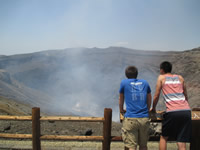
Ben Wang and I marveling at the sight of the magnificent Mt. Aso!
After Mt. Aso, we went to Sangasho Kindergarten to spend some time will all of the little kindergarteners. First, we all got together and made big posters with the children of our handprints and their handprints together. Then, we played a few games with them. One of them was kind of like “duck-duck-goose” which turned out to be very fun and surprisingly difficult with socks on. After that, we all formed into a circle and watched them sing a few songs together and some of us showed off our various talents. Finally, we all gave high-fives and handshakes and then they saw us off. This part of the trip was so much fun! It was really interesting to see how they reacted to us as outsiders coming into their school; they could tell we didn’t belong. It was as if they had never seen any American’s before. They were very shy and didn’t seem very keen on seeing us; however, they quickly adjusted. Before too long they were all running around, shouting, rough-housing, and being as rambunctious as one would expect from kindergarteners. At the end of our stay here, I was chased down and attached by a horde of small children! They managed to pull me to the ground and “dog-pile” me, giggling all the while! It was so much fun to see how excited all of them were and to know that we were a part of that in that moment. It really meant a lot to me to see so much energy and excitement and to know that I had a part in that.
Shortly after this we arrived at our “inn” where we would be staying for the night. We came in and found that dinner had been nearly fully prepared and was laid out beautifully on the table before us in a traditional Japanese way, mats and all. While the hostess was finishing up dinner, we all ran upstairs to put our things in our room. These rooms were interesting, they were just big open rooms with straw mats on the ground, on which we would place our bedding. They were designed to accommodate approximately four to six people per room. After this a few of us went exploring a little and we went to see a couple of the local shrines and temples. Then, we went back to eat dinner and to prepare for Kagura.
After we finished dinner we went to Gokase Secondary School to pick up a few of the students to accompany us to Kagura, an ancient folklore dance. We went to the shrine and after touring around a bit and learning about the shrine and its history; we went in to watch the Kagura performance. Traditionally there are thirty-three dances; however, for this occasion there were only four. The characters were all dressed in very unique gowns and masks and their dances represented different parts of a story about the gods. This story was “The Legend of Amanoiwato.” This story was told as a way to explain a solar eclipse. The performances were all very interesting, though parts of it seemed to be very repetitive and slow. Also, one of the performers wandered off stage during the fourth dance and came over to me and began to cuddle with/caress me in some very awkward fashion. (See picture below). However, over all it was a very enjoyable experience!
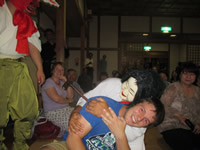
Me being incorporated into the Kagura show in possibly the most awkward and embarrassing way ever…
The next morning we all woke up early and had breakfast, then we left for Gokase. Once we arrived we were greeted by several students who taught us all how to make “waraji sandals,” which are traditional Japanese sandals made out of straw. This was very difficult, but it was also a lot of fun getting to spend time just getting to know each of the other students. Afterward, we went and had lunch with these students in the cafeteria and had a KIP discussion. It was apparent how rare outsiders, or gaijin, were to this school when we were eating lunch. We all got a lot of funny looks and others giggled as we passed by. However, the students we were with were all very proud of us and showed us off to some of their friends. This was a very neat feeling. Following lunch and the KIP discussion, it was our turn to present our project for them. Skylar really spearheaded the project and helped to present an excellent project. We decided to have them construct small motors out of short pieces of wire (copper or aluminum), a battery, and a magnet. Though this is a rather simple demonstration of electrical and magnetic properties, the students really enjoyed it. They turned it into a competition and spent a long time perfecting their designs. It was incredible to see how quickly these students grasped this and how fast and long some of their motors were able to go!
Finally, our home-stay families came to pick us up to spend the evening with them. So we all said goodbye and parted ways. One of the KIP students, Atsushi, and I stayed with Higashiguchi-sensei’s family. (Higashiguchi-sensei was the Super Great Geography teacher at Gokase Secondary School).
After leaving the school, we drove a few minutes down the hill into a quaint little neighborhood hidden back in a cul-de-sac. We pulled into his driveway and he showed us his house and introduced us to his family. He had a wife, a son, a daughter, and a black lab and they lived in a very nice little apartment with a garden in the back and a little yard next to it. After we set down our things he introduced us to his neighbor and we all went outside to talk for a little bit, just getting to know each other. We talked about where we were from and some of the things we liked to do, a little bit about our families, and then we just talked about whatever came to mind. (Wherever I could I practiced my limited Japanese and they all practiced their English, which was very good). It was around this time that his son came out and we played soccer together for thirty minutes or so. It was apparent that he had been practicing quite a bit and was a very talented player, even at such a young age. He showed me his extensive collection of all sorts of cards, balls, and jerseys from various teams from all around the world! After this, we all went inside for dinner. We ended up having handmade sushi made with tuna, salmon, shrimp, and crab, a bunch of different fruits (kiwi, strawberries, bananas), and we even had French fries! It was so much fun making our food and enjoying it, and everything tasted absolutely delicious! After dinner, we sat around the television and just talked for a bit. They were very interested in my life and wanted to know everything about where I was from, the things I did growing up, my school, and just about life in the United States in general, and I was equally interested in learning about their lives and life in Japan. So we sat around and shared stories for a few hours, just enjoying each other’s company and learning as much as possible. They were very interested in meeting my family, so we Skyped my mother and sister back at home so that Higashiguchi-sensei and his wife could talk to them. They were both very excited to see them and told me they would love to meet them again, in person!
The next morning we woke up, had a small breakfast, and then went out to the yard to do some slack-lining (Higashiguchi-sensei was a professional). Then we went to his son’s school and made some small bamboo helicopter toys together. This was a very unique experience, because we had to hand-carve all of the pieces and assemble it, together. It was really nice to just get to watch the two of them bond over something that seems so small. (Higashiguchi-sensei was telling his son and us the stories about how his dad had taught him to use a knife and craft little things like this when he was a boy). After they finished building it, they took it outside to try it out. His son was so excited when he got it to work that he ran all over just showing off his helicopter! Sadly, however, it was time for us to head back to Gokase for the last part of our adventure in Kyushu.
After the NanoJapan students met back up at Gokase, we all exchanged excited stories of our time with our home-stay families. We talked about all the things we did and wonderful foods we had, the different conversations that took place, and how much we all learned during this experience! We all expressed our desire to do it again for a longer period of time, because of how fun and interesting it was to be a part of that (one night was just not enough time). Finally, it came time to say goodbye to all of the families and to head to the shrine. So we all got together and took several pictures and then said our farewells. (This was one of the saddest and most difficult parts).
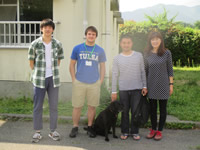
Atsushi-san, home-stay family (minus the children, who were at school), and I, outside of their home in Gokase.
We then went to the Takachiho shrine and had a look around. It was incredible! We had a guide that showed us around the different little shrines and the temple. He even took us to one of the sacred locations, we were not even allowed to take pictures here. It was a beautiful landscape and had significant meaning to the Japanese people in the area. After this, we walked back a ways into a small stream area with a bunch of stacked rocks. These rocks apparently symbolized the dreams and wishes of lovers who had gone there. Each rock in the stack symbolized a different dream or wish that one of the lovers had for their relationship. If the stack fell down, then they were not destined to be with one another. To me this was a very beautiful and interesting sight. I just stood in mere amazement at all of the thousands of small stacks of the dreams of lovers past.
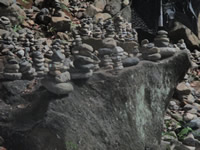
Lover’s Rocks, Takachiho Temple
The part of the Kyushu trip that impacted me the most was definitely the home-stay. It was truly incredible how close you can become to someone in only a matter of hours, especially considering that we came from very different parts of the world with entirely different backgrounds. My host family and I bonded nearly instantaneously. They had a policy based on freedom and choice, not forcing us to do anything and encouraging us to do as we please, so that we might fully enjoy our stay. I thought it would be a very traditional Japanese home and lifestyle; however, much to my surprise, I found that it was not much different than a typical evening back home, except for the Japanese speaking and the sushi for dinner! We mostly sat around and talked, enjoying one another’s company. As often as I could I practiced my Japanese, and they were very good about helping me to learn. They also practiced their English with me, but they could both speak English very well so I didn’t have much to teach them. The best part of this experience was just getting to hear about all of their stories and just learning about their lives. I was very interested in everything that they had to say, and they were equally as interested in my life, if not more so! I’ve never had someone that interested in learning about my life and Oklahoma, so it was really interesting for me. I learned so much from them and hope that they learned as much from me. I enjoyed every second of my time with them, and this is an experience that I will carry with me for the rest of my life.
Orientation Program Overview
During orientation I felt that the most helpful things were the various cultural outings and lectures and the Intro to NanoScience lectures. After participating in these I felt that I had a better understanding of different Japanese cultural things and I felt much more confident and prepared when it came to my research. These all helped me to get over my initial fears and to become much more comfortable.
In regards to language classes, the most helpful thing was the high degree of involvement and repetition. Also, the homework, though tedious, was very useful in our understanding of the material. It was very important to have memorized the Katakana and Hiragana as thoroughly as possible before arriving! It has proven to be invaluable! One strategy I have employed to help me learn Japanese I call the “get out there and do it” method. I take every opportunity I get to go up to people and practice my Japanese, even if they speak back to you in English, at least it shows that they understand you and you get some practice. Also, you help them to get some practice too! Another strategy is to just memorize as many useful things as possible and to branch out from there. Constantly ask questions! The last useful thing to know is just try to pay attention as much as possible to what others are saying, even if it isn’t necessarily your conversation. A lot of times you will find that you hear a lot of useful phrases and you may even learn to decipher conversations just based on the few words you know!
The most important thing I didn’t know about Japan but that I know now is the emphasis they place on such small gestures, apologies, etc… A lot of times you may find yourself at fault for something, but if you show that you are sorry and you make the right gesture, it can quickly turn the situation around. That is not to say it is ok to mess up on purpose and just apologize, but oftentimes a sincere apology can work wonders. Also, they have a very high reverence for certain things that may seem small to us, but are rather important to them, especially the shoe thing.
Some questions I still have about Japan:
Intro to Nanoscience Lectures
This week we had three Intro to NanoScience Lectures, two by Professor Christopher Stanton and one by Professor Taiichi Otsuji. These lectures covered more in depth topics regarding introductory solid state and condensed matter physics.
Professor Stanton’s first lecture was a rehash of solid state and condensed matter physics and basic quantum mechanics, such as energy gaps. He talked briefly about band diagrams and the optical properties associated with band gap transitions. Also, he talked about photovoltaics and other solid state device functions, such as LED’s, lasers, and diodes, including the properties of doping, junctions, and confinement.
Otsuji-sensei’s lecture was about Graphene Terahertz Science and Technology. He talked about the innovations of technology due to nanotechnology and the various possible applications of Terahertz science and technology. Then, he covered the fundamentals of graphene, including the band structures, carrier distributions/carrier transport, electron/hole mobility, and synthesis. After that he introduced us to some of the basic principles of lasers and the idea of a graphene terahertz laser. This was a very good introduction to the possible applications of THz technology and graphene, and introduced me a bit to what my anticipated project is this summer!
Professor Stanton’s second lecture gave an introduction to the principles of femto-second spectroscopy. He discussed types of lasers (pulsed versus continuous wave) and then gave an introduction to transport theory. He taught us various types of scattering, due to things such as phonons and impurities/defects. Also, he talked about electron-hole recombination and relaxation time. Then he talked about Nanoseismology and how to generate THz radiation from femto-second pulsed lasers. Finally, he gave some of the reasons why we are so interested in terahertz research.
When Monday morning came around, the first day I was to begin my time in the lab, I was very excited and I got up early to greet Hiroyuki-san, a first year Master’s class student in my lab, who had agreed to pick me up and show me the way to the university. After about a thirty minute walk through town we arrived at Katahira Campus, this is where my lab is located. Once we arrived, Hiroyuki-san took me to my desk and showed me around the office. I have a nice little desk next to the window, overlooking part of the city. I find that sometimes when I need a break or inspiration it helps to just look out and see Sendai all laid out before me. Next, he introduced me to some of the other students who were also working in my lab, though many of them didn’t trickle in until later in the afternoon. He also introduced me to a couple of the professors and other more senior members of the lab, including one Post-Doctoral student, Watanabe-san, an Assistant Professor, Satou-sensei, and an Associate Professor, Stephane-sensei.
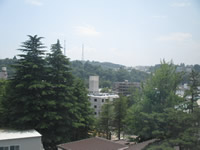
View from my desk in the office
Shortly after this, a study abroad student from Georgia Tech, who is also working in the lab with me this summer, and Adi-san, a Research Fellow at the university, took me to the lab to see some of the ongoing experiments and introduce me to the equipment. The experiments were very interesting, testing Terahertz gain of graphene using pump-probe spectroscopy, and the equipment was very high quality! They are currently in the middle of constructing another experimental setup for further experimentation.
Following the lab tour, they took me to the cafeteria to get lunch. The cafeteria here isn’t much different than the one back home; however, it is quite a bit smaller and the food is a little better! During lunch we all talked about what the research life is like and a little bit about the campus and surrounding town of Sendai. They gave me some advice on fun/interesting things to do in town and also on some of the lab related things.
When we returned from lunch, Watanabe-san, Arnold-san, and Hiroyuki-san took me to the other lab and showed me some of the things they were working on. Their lab was significantly more advanced, though they too were working on terahertz and graphene based physics. It was really interesting to get to see all of the equipment up close, because I was able to ask questions and they could explain to me in more detail how everything worked, the purpose of the experiments, and the theory behind what we were trying to observe. Also, they let me help them run one of the experiments while I was there, which was super neat!
Finally, we returned to the office where I got to meet the rest of the students who showed up later. We all sat and talked for a bit, getting to know each other, and then around 6 p.m. we left to head back home. It was a very busy first day in the lab!
I don’t particularly have a single mentor, all of the students try to work with me and help me out in any way they can, in and outside the lab. However, Hiroyuki-san is the one I have been working most closely with so far. He is very relaxed and easy-going, though he seems kind of quiet and shy, but he speaks English very well. He and I have made an agreement to help each other practice our language skills throughout the summer though! My interaction with the rest of the students has been very successful and enjoyable! Everyone here is very relaxed and they all have a great sense of humor! However, when it comes time to research and get things done they are all very diligent and productive; it is amazing to see how focused and determined they all are! Regardless, they are all very friendly and we have enjoyed getting to know one another so far and I look forward to getting to know them better throughout the summer!
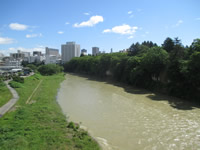
River near our dormitory
As far as language goes, everything has been pretty smooth sailing. The majority of talking done around the lab is in Japanese, especially when they are talking to one another. However, if any of them are talking to me or if I am involved in the conversation (such as meetings and things like this) then they will talk in English. The language barrier hasn’t been too much of an issue, everyone here speaks English very well and except for a few of the more complicated concepts, they are all able to communicate what needs to be said.
For housing we are staying at Urban Castle Kawauchi, an international dormitory located near the river. Because Ramya and I are on the same campus, we usually walk to and from the campus together every day. We have both been told that we will be able to rent bicycles for the summer, but we haven’t had the opportunity to get them yet. When we do we will probably ride them back and forth on the sunny days. It has taken me some time to adjust to living here because it is fairly different than living back home, but overall it is a pretty decent place. The building is gender-divided by floor, the showers are communal, and the rooms are small but cozy and they come with most of the necessary furniture. The beds are a little bit hard, but after a couple nights of sleeping there you get used to it. Also, there is a kitchen and a lounge downstairs where a majority of the students congregate in the evenings. This is a very nice place to just unwind and relax with some company after a long day in the office. Students will often get together and talk while cooking dinner, lounging on the couches, or playing ping-pong. The most interesting thing about living here is all of the people I have encountered and gotten the chance to meet! I have met people from all around the world, many of whom are here to do research as well. It is very interesting to get to sit around in the evenings and talk to them, to hear about the places they are from, and to discuss their research and other topics of interest. I have already made several friends and hope to make many more!
Every four years, we are blessed with the greatest spectacle known to man, the FIFA World Cup, and this just so happens to be one of those years. For me, this has been one of the best ways to meet and associate with the other students, despite the fact that is usually happens from 4 to 8:30 in the mornings. Typically all of the other hardcore soccer fans and I will meet in the kitchen area and crowd around the television to watch the matches, cheering for our favorite teams and watching the dreams of thousands live and die within the scope of 90 minutes. Nothing facilitates bonding quite like soccer!
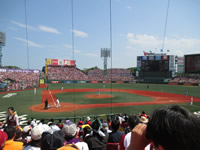
Baseball game, Eagles versus Giants (Giants won 3-2 in the 9th ) :(
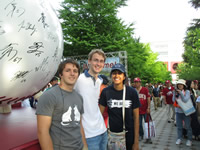
Sendai Squad just outside the Kobo Miyagi Stadium!
Otsuji-sensei has provided me with a tentative week by week schedule for the duration of the summer. The first few weeks are to be devoted to familiarizing myself with the lab, materials, and theory behind our research. I have been studying a lot about semiconductors from a book Arnold-san lent me titled Physics of Semiconductor Devices. Once I feel comfortable with this I will move on to graphene physics and becoming familiar with terahertz physics. Though it has been difficult, I am glad that I have been allotted time to study the theory. Initially I was worried and confused, but I feel like I am learning a lot and becoming more familiar by the day. Any questions I have had I have been able to search online or to ask questions to my lab members, they have been very helpful throughout this process.
Once I have familiarized myself with the research, I can begin my project. My project theme has changed slightly from the original one. Now I will be doing an experimental study on nonlinear terahertz electromagnetic response in gated double-graphene-layered structures (DGL). I will be concerned with the quantum-mechanical and plasmonic properties in graphene and the interaction of infrared and terahertz radiation in graphene.
During my time here, the most critical incident that I have been “involved in” was at the restaurant following our trip to Asakusa. After we had all finished with Sumo and visiting one of the shrines there in Asakusa, we decided to go eat at a very nice little restaurant in town. There were approximately 20 people or more in our group, including the 12 NanoJapan students, Packard- sensei, Kono-sensei, a couple other professors from other universities, and a handful of KIP students.
As we were all filing into the restaurant, we were directed to a very long table near an outside edge. Between the door and our table there was a large support beam, a table with another family eating dinner, and a very narrow walkway. Just on the other side of the beam, barely visible from where we were walking from, was a chair. In this chair, standing directly upright was a very expensive bottle of wine hidden away in an eloquent green paper bag. Shortly after we passed by the beam and began heading to our seats we heard a very loud crash, one that stopped us all in our tracks. We turned around to see what had caused the noise and were devastated by what we saw. On the ground was a green paper bag, surrounded by a pool of dark red liquid. At first we were all too stunned to move, shocked by what we saw. Once we could make sense of the situation, I rushed over and began to pick up the pieces and to try and clean it up. I attempted to apologize and offer to pay for the wine, but was stopped by one of the KIP students and told to just wait a minute.
We all stood by and watched as the waitress finished cleaning the mess and tried deliberating between the KIP students, Packard-sensei, Kono-sensei, and the family to whom the wine belonged. Initially, everyone was just trying to understand what exactly had happened. The best that we could come up with was that as we were passing by, scrambling to get to our seats around the table, one of us had accidentally bumped the chair in some way and knocked the wine over. However, there were four or five of us who had passed by around the time that the wine was broken, so none of us were sure who exactly was responsible. We all expressed the fact that we were sorry and wanted to help, but we were told not to apologize just yet because it was, in essence, an admission of guilt, admitting that it was our fault.
We quietly sat down at our table and ordered our food, mistakenly thinking that things had been relatively settled. Halfway through our meal, the police arrived. Five officers had come to the restaurant to investigate the issue and to clear things up. Packard-sensei and Kono-sensei went with the family and the officers out into the hallway to discuss the issue. A few minutes later, one of the KIP students allowed us to go out into the hallway so that we could try and apologize. However, upon our arrival we found that everything had already been paid for and the family was smiling and talking contentedly with Packard-sensei. Before we even had the chance to say anything, the family had left and Packard-sensei took us all back in to finish our meal.
After things had settled a bit, we found out what had upset the family so much and why the police got involved. First off, the family was upset that no one had apologized. They felt as if we didn’t really care about the situation and felt like we were not responsible for what had happened. Secondly, when we asked how much they paid for the wine and heard their response, a couple people exclaimed things such as “That’s expensive” or “Who would pay that much for wine.” This really upset them, because they felt like we were calling them liars. Finally, to top it all off, they were there celebrating a birthday. It was the young woman’s mother’s sixtieth birthday. At first this didn’t mean much to us, but apparently in Japan someone sixtieth birthday is a very big deal and they typically make a huge celebration out of it. Once we realized all of these things, the true magnitude of what happened caught up with us.
Reflecting back on this situation I recognize a few things that could have gone much differently, which could have greatly affected the outcome. Initially, we could have been more aware of our surroundings and taken extra precautions, as we were a big group in a small area. Secondly, we could have seemed more concerned about what was going on. I understand that we were stopped from apologizing, but we could have done something that showed them that we truly were sorry and didn’t mean for anything like this to happen. Also, we should have been more considerate with the things we said. Even though we were speaking English, it is very plausible that they could understand what we were saying, even though they may not have been able to speak English very well.
This situation really challenged our Japanese speaking abilities as well as our understanding of certain Japanese cultural aspects, especially regarding high emotional/stress situations. The family was less concerned with the fact that the bottle of wine had been broken, but more concerned with the way our group responded to it. This shows a lot about Japanese culture and their emphasis on interpersonal connection rather than materialism. I think that, even though this situation was beyond what we ever anticipated happening here in Japan, a lot of us learned a lot due to this situation.
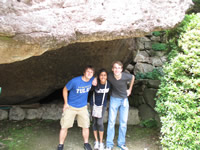
Sendai Squad on our trip to Yamadera
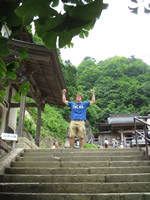
Rocky pose at the top of the 1,000 stairs!
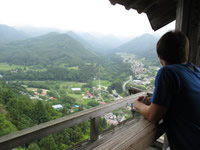
Looking out over the surrounding land from the top of Yamadera!
Research Project Update
This week I have been doing a lot more reading on graphene, including its properties, uses, and different devices and materials that it could possibly be used for. Accompanying this, I have been reading more into semiconductor physics and some solid state physics. Otsuji-sensei has recommended that I continue to look into these subjects for the first few weeks so that I can develop a broader, more complete, understanding of these subjects before we begin working on my actual project.
Aside from just reading and studying up on some of the subjects, I have also been attending a few lectures and accompanying some of the other students during their experiments. I have learned the basic setup and goals of some of their projects.
One project that is being conducted is to use pump-probe spectroscopy methods to determine the terahertz gain in graphene. The other two projects are working together. The first is the FTIR (Fourier Transform Infrared Radiation) device. This device is used to test the optical properties of graphene in the terahertz region to determine whether the quality of the graphene sample is good enough or not for use in device fabrication. It utilizes an infrared laser source to generate the terahertz radiation, which is sent into an evacuated chamber with a bolometer detector, through a graphene sample. The properties of the graphene are then plotted out onto the computer, where we can determine the quality by comparing the observed signal with the background signal. The second part of this project is to determine whether the fabricated graphene device can be used as a detector for terahertz radiation. This is done by simply generating a terahertz pulse and making it incident on the graphene in the device and then measuring the resulting voltage or photocurrent. This has proven to be quite difficult, however. We still haven’t been able to collect any data on this particular project, but we are still hopeful that something will come through soon!
At our laboratory everything is very laid back and casual. Though there are a few “rules” that govern interaction in the lab, they typically aren’t followed so strictly. Everyone here is very friendly and there is a strong sense of friendship among all of the lab members, which makes sense as they spend a majority of their time together throughout the week. They are all very comfortable with one another and the conversations are very casual, often including a lot of joking around and laughing with one another. Though it isn’t done very often, typically when higher ranking students talk to lower ranking students they use their name followed by “-kun.” This is always used when professors are speaking to students. A lower ranking student speaking to a higher ranking student will nearly always use the suffix “-san.” When speaking to a professor all students use the term “ -sensei,” though it is also sometimes used jokingly among the students when one student is very knowledgeable in a particular area or just to embarrass someone.
All of the older students are very helpful to the younger students, encouraging them to ask questions anytime. However, this does not happen very often. The office has individual cubicles for each of the students, typically with the more advanced students (Master’s class and above) on the side apart from the sensei and the undergraduates together on the same side as the sensei. To me, the cubicles make it difficult to ask questions, because they are meant to keep everyone focused on their work. Though they encourage us to ask questions, I feel really bad if I break their train of thought and distract them from their work. I have also noticed that this is an issue with some of them, because they will often sit and struggle with a technical problem, sometimes for an hour, before they will ask for help. However, there is a small table with some snacks and coffee or tea, which students will sometimes gather around throughout the day for a small break. During this time we usually just relax and talk for a bit about our how our days are going, our plans for the weekend, the World Cup games, or just whatever comes to mind. If someone has a question it is also usually addressed at this time, so as not to distract anyone else while they are concentrating.
Disagreements usually don’t occur in the lab very frequently. If a lesser ranking student disagrees with a higher ranking student, he might politely suggest an alternative. If the other student agrees then that’s what they do. However, if he disagrees still, then they will just do whatever the higher ranking student feels is appropriate. Once this is decided, there is no arguing or secondary plea. If a higher ranking student disagrees with a lower ranking one, he will suggest an alternative and the student will immediately comply. In some instances this is a very effective and efficient method, as it reduces the amount of time spent squabbling over details and arguing about whom is right. However, on the other hand, it can sometimes be very inefficient if the senior misjudges the situation and an unnecessary experiment is performed by accident.
Regarding the daily schedule during the week I usually arrive at my lab around 9:00 or so every day, and am usually the first or second one there (occasionally Sato-sensei or Watanabe-san might be there already). The other students arrive sometime later, a few around 10:00 or so, but most arrive closer to noon. Upon arrival, everyone greets one another and then quickly settles into their desk space to begin their work. The students are all very focused on their work once they get into the lab. Though I leave around 6:00 pm every day, almost everyone else stays there. It is not uncommon for many of them to stay until 10:00 pm or even midnight! Most of the students will be working on their research or work for other classes during this time. It seems as if they use the office space as a sort of quiet study space to prevent them from being tempted or distracted.
Though most students stay well into the evening, the most valued thing isn’t necessarily the long hours every day, but hard work and dedication. They love to see you get results, but they recognize that this is cutting edge research and that results cannot be guaranteed every time. They focus mostly on the fact that you are working hard and doing your best to understand the project and to contribute in some way. The students are all very dedicated to their work and enjoy what they are doing. This, in itself, is incentive for them to work hard and stay later. Teamwork is also very valued. Oftentimes experiments are done with three or four people all there helping out and learning. This is a good time for the younger students to get a hands on approach to research by learning how it is done, as well as a good way to encourage teamwork and critical thinking.
Our daily life in the lab, though it is somewhat like what was described in orientation, is very relaxed and easy going. I was prepared for a more rigorous, strict set of rules and protocol to follow, but was pleasantly surprised to see that was not the case. Everyone is encouraged to ask questions and get involved. The other students like to see you give data analysis and try to determine what is going wrong, which is different than what was explained during orientation. On the other hand, the Japanese way of saying yes and no is exactly how it was explained. They never give a stern yes or no answer, but rather they politely suggest it in some form of “maybe or perhaps (for yes)” and “that might be difficult (for no).”
I have not actually had any previous experience in a United States laboratory, but I feel like it would be very different. The Japanese lab seems to be very focused on teamwork and a sense of unity and harmony in the lab. In the U.S., I feel like it would be much more individual oriented and that disputes would be handled in a very different way. Also, in the U.S. students, I feel, would be much more open to asking questions than in Japan. This would seem to make things more efficient in terms of time, but wouldn’t really work much to stimulate independent critical thinking skills. Finally, in the U.S. there is a sort of hierarchy, but it usually isn’t so pronounced. The Japanese hierarchical system is very apparent and tends to determine a lot of how things are done around the lab. I am not sure which system I would prefer, as both system offer obvious pros and cons. I think both systems work in their own way due to the various cultural differences that we have.
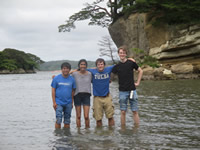
Matsushima Bay with Professor Santos, Ramya, and Ben
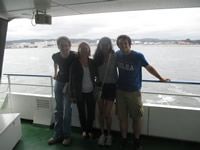
Boat cruise at Matsushima Bay with the Sendai Squad and Sarah-san
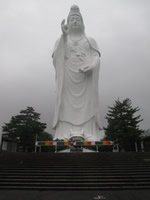
Sendai Daikannon Statue
Research Project Update
This week not much has changed from last week. I have still been concentrating on learning the material and performing some experiments with the other students. We had a little bit of trouble with one of the samples during the detector experiments last week, so we had to order a new sample. It finally came in and we were able to perform some measurements on it to see if it had the properties we were looking for and to make sure that it was a good sample. So far everything seems to check out and I anticipate that we will begin a more intensive investigation of our material in the next few days.
Since Otsuji-sensei has returned I have had a couple additional lectures and he has given me more directions on getting prepared for my experiments. Once we return from our Mid-Program Meeting we will begin to write the abstract and continue performing more experiments to collect some data. This project is very cutting edge and therefore, it has been difficult to obtain results. However, I am hoping for the best and am still working very hard to produce results.
As the Mid-Program meeting approaches, it is our time to sit and reflect on our experiences up to this point, including our accomplishments and challenges we have faced, especially in regards to our personal growth in and outside of the laboratory setting. I am very much looking forward to meeting back up with all of my fellow NanoJapaners to share about my progress, as well as to hear about all of their accomplishments. I am hoping that this opportunity to share with everyone, and for them to share with me, will only further encourage me to keep improving throughout the last few weeks here in Japan.
Prior to my arrival in Japan I had a condition that could be classified as “existing beyond the scope of an addiction,” which was characterized by the fact that I drank anywhere from twelve to fifteen Dr. Peppers every single day. This had gone on for years, since my freshman year in high school. I had become dependent on it. I could not concentrate on anything and I suffered from terrible migraines and severe withdrawals whenever I didn’t fill my quota. When I arrived in Japan I had expected that I would not be able to find it anywhere, which couldn’t be further from the truth. Tokyo had Dr. Pepper in several vending machines and konbini’s around where we were staying, which allowed me to maintain a semi-stable intake. This was quite an expensive habit in the United States, but even more so here in Japan.
About two weeks into the program I began to think about what my purpose here in Japan was and what I really hoped to get out of it. I had often used the phrase “life-changing experience” to describe this trip; however, I never took the time to fully reflect on this fact. I realized that I would be experiencing an entirely new culture, I would be getting to step back into history, and I would be performing cutting edge research. But was that all I was supposed to accomplish, or was there something more? I decided that it should be about much more, about a personal growth as well. So, finally I decided to put my words into action and to really make the most of everything during my time here. As a first attempt to truly make this a life changing experience I decided to give up drinking soda altogether, including Dr. Pepper. I had quit cold turkey. The first couple of weeks were a real struggle. I couldn’t focus very well and I had severe migraines every day. I felt physically sick and lifeless. Several times I nearly relapsed, but I forced myself to remain strong, along with the encouragement of others. Finally, the pangs of desire began to fade away. I began to feel like I didn’t need it at all and eventually I began to not even want it. I could look at it and not even feel the slightest inclination to have it.
To me this was a tremendous milestone, but I didn’t stop there. I decided to push this new found confidence and drive into other areas of my life. For the first time in about three years I began to exercise again to try and get into shape. I went from not being able to run a mile without being winded to running three or four miles at a time. Also, I began to cook for myself for the first time in my life. I had always relied on dining out or some sort of microwavable dinner when I wasn’t at home, or the cafeteria when I was at school. Though I had watched my parents cook for years, I had never actually taken the time to learn. Since I have been here in Sendai I have cooked for myself on most nights and have been thoroughly pleased with the outcome. Finally, I began to teach myself how to program. I had taken a class before, but had never really become proficient. I realized once I got here just how useful programming would be and how much others in my field have come to rely on it. This made me wish I had focused on it more in school and made me desire to pursue it once again.
So what started as a simple addiction to Dr. Pepper has transformed itself into a drive for improvement. I have begun to look for ways to improve in all aspects of my life. Prior to coming here I had a severe lack of motivation to accomplish anything. I was barely skating by and was relatively content with everything. But then I came to Japan and being here became a catalyst for change. Now I feel empowered and motivated to keep pushing forward and improving in any way possible. This, I would say, is my greatest accomplishment since coming to Japan.
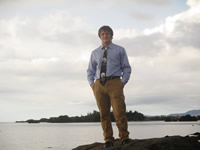
Albert Einstein and I enjoying our view from the beach in Okinawa
However, not everything has been an uphill adventure for me. Despite overcoming my addiction, I have suffered several personal challenges as well. My biggest challenge up to this point would probably best be characterized as adapting. I have never had the opportunity to travel much in the United States, let alone outside of the United States before, so I am not used to having so much to keep track of. Because of this I often find myself doing incredibly stupid and forgetful things. Though I am typically a fairly responsible person, I find that isn’t always the case here in Japan.
I cannot tell if it is simply the exhaustion from having so much to do all of the time or if it is the excitement of everything that I am able to do here that causes me to be so forgetful. During our second week in the program, while we were still undergoing orientation in Tokyo, I managed to somehow wash and dry my passport while I was doing laundry. I had assumed that I placed it somewhere in my room and that I would find it later, but apparently I had accidentally left it in my pocket and washed it with my clothes. This proved to be a very expensive mistake, as I had to take a trip to the US Embassy in Tokyo and apply for a new passport to the tune of $150. Not even a full two weeks later, when doing laundry in my dormitory in Sendai, I managed to leave my wallet in my pocket, which I found after the washing cycle had finished. This was a significantly cheaper mistake, which cost me only $30 (that was shredded while being washed) and a few tickets, brochures, and travel guides that I intended to use as memoirs of places I had been. Finally, to top it all off, I decided to take a swim in the ocean without realizing that I still had the hotel key tucked away “safely” in my pocket. This fact quickly became apparent when Ben decided he was done swimming and wanted to return to the room. It was in this moment that I realized that they key was no longer in my pocket. Despite the fact that we only swam and played in one small section of the ocean, four hours of snorkeling in search of the key proved futile. This was the most expensive and stupid mistake that I have made up to this point, costing me approximately $162.
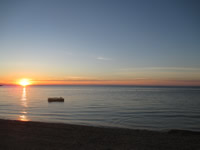
This is the very part of the ocean where I lost the key and spent hours snorkeling in hopes of recovering it
So up to this point I would say that these have proven to be the greatest challenges I have had to overcome. Though they have been costly, I am hoping that they will begin to teach me that I need to be more conscious of my surroundings and that I should be more careful. Also, it should teach me to always check my pockets carefully before approaching anything that has water.
In regards to my research, everything is progressing slowly but surely. We have yet to obtain any definitive results, but we are continuing to push forward. As of now I am focusing mostly on getting everything ready and preparing to write my draft of the abstract for the RQI poster session that I will be participating in during our re-entry program in August.
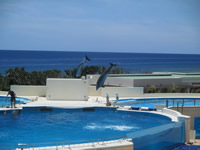
The Dolphin show at the Churaumi Aquarium
Research Update
Research is progressing slowly but steadily. We are continuing to do experiments on our new sample and hoping to achieve some useful results soon. I am hoping that we will be able to perform another experiment in the next few days, since everyone has been so busy and we haven’t been able to have one in a while. In the mean time, I will be concentrating on preparing my abstract and poster for review.
Mid-Program Meeting Overview:
During our stay in Okinawa we were able to participate in a lot of really neat things, including a tour of the Okinawa Institute of Science and Technology Graduate University (OIST). This school was incredible! One interesting thing about this university is that it is for graduate students only, which is very unique as I have never heard of an “only graduate university.” This school also seemed to have a strong focus on science related fields, with little or no interest in anything else. However, the way the school is set up encourages a wide variety of cross disciplinary collaboration among all of the researchers there. In a typical university there are departments that are concerned with only a single focus (such as the chemistry department or physics department) and are separated from one another, but that is not the case at OIST. At OIST there are no boundaries between “departments.” All of the offices are mixed together and many of the researchers share equipment or laboratories. The campus is set up so that it is nearly impossible to avoid interacting with someone outside of your discipline as you walk around during the day. I am a huge fan of this philosophy, as the greatest gains are made when people work together.
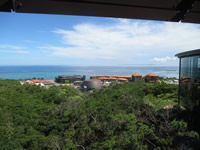
An example of the beautiful architecture and view from OIST
The facilities were absolutely incredible! They had numerous laboratories and experimental setups which were all composed of state-of-the-art equipment. It was really incredible to be able to walk through the school and see the experiments and hear about all of the research being done. The campus itself was comprised of many beautiful buildings overlooking the ocean. The architecture was incredible and the view was unparalleled. Perhaps the most interesting thing about OIST, however, was how diverse it was. All classes were taught in English and over 50% of the faculty and students enrolled were international. It was really interesting to talk to some of the students and get to know them and to hear about where they were from and how they ended up at OIST. Also, the faculty and students seemed to share a very close relationship with one another, characterized by a mutual respect for one another and a love of science. This was reflected in the way the students and professors spoke about their research. They were all very knowledgeable about their fields and very passionate about what they were doing. From the atmosphere to the relationships among students and faculty, I believe that everything about the university is very conducive to the academic work that is going on. For this reason I believe this school will be very successful.
Aside from touring OIST, all of the students were also able to participate in a lot of other fun activities. Many students got to see a traditional Okinawan dance that took place in our hotel one evening, while also getting to try dozens of various Okinawan dishes, most of which consisted of delicious meats. Many of us also spent a lot of time on the beach, swimming and playing in the beautiful waters for hours at a time. In the evenings, a lot of us would get together and go out for dinner or just go for an evening on the town. On our final full day in Okinawa, we were able to take a trip to Ryukyu Mura Village and to the Churaumi Aquarium. Ryukyu Village was a very interesting place. It was a small recreation of a traditional Okinawan village. There we were able to see what life might have been like back then, while also seeing a traditional dance, eating some interesting foods, and shopping for a wide variety of souvenirs. The aquarium was magnificent! It was very big and had quite a few different types of sea life, including Whale Sharks (which are fairly uncommon in the US). Also, we got to see a dolphin show, which was really awesome!
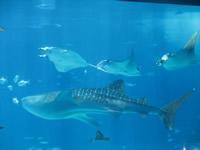
A picture of one of the Whale Sharks and a few Manta Rays at the Churaumi Aquarium
The Mid-Program Meeting was a phenomenal experience overall, despite that I had a hiccup or two. It was incredibly nice to be able to take a small break from the day-to-day routine and laboratory work and to just spend some time relaxing by the beach with the crew. Okinawa was absolutely gorgeous, aside from the searing hot temperatures and humidity, so it was a perfect place for all of us to have a “getaway.” During our orientation in Tokyo, many of us bonded and became very close with one another. Because of this, in my opinion, the best part of the Mid-Program meeting was the chance to meet back up with all of the other NanoJapan students and to hear about all of the stories they had and their adventures in each of their respective cities. It was neat hearing about all of the failures, setbacks, and successes of each of the students in regards to laboratory work and/or personal life, as we all shared similar struggles. I was very grateful that we had a lot of down time to just spend together sharing smiles and making memories that we will carry with us for the rest of our lives.
Japanese Language
Learning Japanese since I have been here has been very difficult. I started out with absolutely no experience before I came and have been slowly trying to learn. The orientation program in Tokyo was great, as it included three weeks of intensive language study. During this time we learned a lot of useful vocabulary and phrases and some very basic sentence structure. From this, though my ability to speak was very limited, I could communicate some basic desires and formulate some questions. However, since then I have not had much opportunity to practice my Japanese language skills, except in the streets. In my laboratory most of the students are Japanese; however, they all prefer to communicate with me in English and that I communicate with them in English, so that we don’t have any miscommunications and such. I try and use the phrases that I know as frequently as possible, but they aren’t very useful for many of the day to day interactions. Every now and then some of the students will speak to me in Japanese and try to have a small conversation, but it is usually never more than a few words or sentences. Most of the time I simply listen to what is being said and I can occasionally pick out certain words I know. From this I can guess what the conversation is about.
Ramya and I are currently taking a class taught by a volunteer teacher twice a week for an hour and a half at a time. This helps a little bit, as we cover more about sentence structure and particles that we had a difficult time grasping at first, but the classes are too short and infrequent for any really intensive study. The class is mostly a review of what we learned back in Tokyo, so it is hard for me to gauge how much I am actually learning, but it is good for practicing what we have previously learned. We have concentrated on learning a few of the more useful/common kanji, so that we might be able to discern a few of the words and phrases we see on signs or in the station, etc… Also, our instructor is very useful in answering any questions that we have, which is very useful for learning purposes.
The Japanese language has been very difficult for me to learn, because of the many intricacies and the large amount of vocabulary, but this makes me want to learn it even more. I hope to take some future classes to continue learning Japanese and will continue with my personal self study as often as I can. I have a few phrases I am confident with, but others that I am still not so confident with. Because of this I often find myself using only a few phrases and am too nervous to practice the others that I am learning, except inside the classroom. Every now and then I am able to celebrate some small victories when I can have small conversations with random strangers and even ask them to take pictures with us. It isn’t much, but it is nice to see that I have learned some Japanese. Right now I still consider myself to be a beginner, but I am hoping that during the rest of my time here I will be able to continue improving.
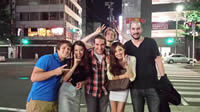
Some friends from our dorm and I after a night on the town with some random Japanese “hotties,” which I asked to take a picture with us in Japanese. Small Victories.
Research Update
We managed to get some work done on our experimental setup this week. We finally got the UTC-PD up and running again and we were able to generate some terahertz radiation with it. We tested it using the bolometer to make sure that it works before performing further experiments on our sample. We are hoping to take some data on our sample this Wednesday and possibly on Friday as well, as those are the only days we have access to liquid helium. If our theory is correct, then we should see some interesting results in the next few days (hopefully).
On a side note, I have completed my draft of my abstract and have sent it to my U.S. Co-Advisor and to my research host advisor for review. Once they get back to me I will be able to revise and submit a final draft. I will now begin working on my poster and should hopefully complete it fairly soon, assuming that further experimentation proves successful.
The life of a great scientist can be thought of in a way very similar to the life of a dying star. Most live relatively normal lives, gradually achieving peak luminosity and then slowly deteriorating in a general wearing out process. A few appear like supernovas, exploding onto the scene in a magnificent flash of brilliance and wonder before suddenly disappearing from sight, only to be held in our memories forever. Finally, there are those who quickly swell to a magnificent size, burning with the fire of a million suns, only to collapse under the pressure to a dark, dense point in space, remote and forgotten. The tragic story of Haruko Obokata is much like the last.
Obokata was a brilliant young researcher at the RIKEN Center for Developmental Biology in Kobe, Japan. She was driven by a dream to do something that would greatly benefit humanity and change the world forever, so she sought a career in the life sciences. After receiving her Ph.D. she began to do serious research on STAP Cells (stimulus-triggered acquisition of pluripotency), a potentially safe and effective replacement for STEM cells. Eventually, she had a paper published in Nature, in which she detailed her team’s discovery of the easiest method to create STEM cells. This was a groundbreaking discovery of “Nobel – proportions”. The media went into a frenzy and Obokata achieved a “superstar” status, becoming world – famous virtually overnight. In a country where female researchers are greatly underrepresented, a discovery such as this led Obokata to become the poster child for all female scientists, present and aspiring. This became a very large burden to bear for her and even enraged her slightly. Her goal was to make leaps in science as a scientist and not simply as a woman. The fact that the media concentrated so much on her being a woman, commenting on her fashion and the way she decorated her office, instead of her strides as a scientist seemed demeaning to her in many ways.
However, while the media was concentrating on her because she was female, other researchers began to focus more on the work she had done. In doing so they discovered a few discrepancies in the results she had published. Many researchers tried to reproduce her works under the same specifications she had stated, but every attempt failed. Eventually it was determined that Obokata had, in fact, misrepresented her work. She used one figure from previous work she had done (her doctoral thesis) and she had swapped two lanes of another diagram. Once these issues were noted, investigations began to take place to determine whether or not this was intentional academic misconduct. After many investigations and committee hearings, Obakata was found guilty of intentional scientific misconduct. She did not deny the fact that she had made mistakes, however; she insisted that these mistakes were the results of inexperience, not mal-intent, and that her conclusions were still correct, despite these figures being tampered with. She insists that if she had access to her computer and laboratory, she could reproduce her previous results.
All of the controversy surrounding this issue took its toll on Obokata. Despite her efforts, she was unable to garner a re-investigation and was unable to appeal the accusations against her. Also, against her desires, it was recommended that her paper be retracted. She was eventually admitted to a hospital because of the condition of her mental and physical health. She suffered a “falling – out” in the scientific community because of her actions and the conclusions of the inquisition.
This story definitely highlights a terrible and tragic issue among modern scientific exploration. Science, in many ways, is a collaborative effort to garner and compile knowledge in search of a higher truth. However, it is not the friendly playground that we imagine it should be. It is a bloodthirsty and competitive field of battle among the most creative and intelligent minds of our time. With thousands of researchers in any given field each seeking fame and fortune, racing to find the answers, many are willing to do whatever it takes to make sure that they stand above the crowd. This drive to be the best, along with the pressure to publish before anyone else does, definitely lies at the heart of the problem. In order to differentiate yourself from the crowd you have to accomplish something truly great, you have to have done revolutionary, groundbreaking work. I believe that her drive to achieve and the pressure to beat the competition is what pushed her to fabricate certain results, not any direct intention to mislead others. As a scientist she recognizes the importance of the truth and honest results, so it is doubtful that this was a malicious intent to mislead.
I believe that the reason this issue garnered so much attention was not so much because of the scientific misconduct, but because of what Obokata represented. She was an extraordinary female scientist and she became a symbol of all women in science. This is not the only time academic misconduct has occurred. Among the scientific community academic misconduct is fairly common, though not always to a degree of this magnitude. The media is largely to blame for the amount of attention devoted to this instance and is largely responsible for many of the adverse consequences.
As an aspiring scientist, I can sympathize with Haruko Obokata. Though I do not condone her actions, I can understand her motives. Of course I do not think that falsifying scientific data is acceptable, but her reasons for doing so are something that is shared by the majority of scientists today. I believe that many of us scientists share the same drive, passion, and desire to succeed and to contribute something great to the world. We all have a drive to discover the truth and a quiet desperation to find the answers, a passionate curiosity for the unknown, and a desire for recognition and distinction. Any time there is a competitive situation in which one person is capable of coming out on top, people will find ways to bend the rules and “cheat” in order to win. Since the scientific world is such a competitive place, these qualities and desires often push people to do things beyond the scope of their better judgment. Occasionally someone will make a mistake and get caught, as is the case here. The immense amount of competition can have far-reaching and profound effects on science.
The real tragedy here, however, is not that someone got caught cheating the system, but what the world lost as a result of that. Because of this event, the world lost a great researcher, one with true potential to change the world. Even if she is able to continue her research, she will be scarred mentally and emotionally, causing her work to suffer, and any work she does produce will be heavily scrutinized.
“Waterfall” at Kiyomizu-dera Temple in Kyoto
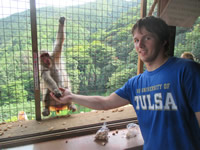
Interacting with the Japanese Macaque Monkeys at Iwatayama Monkey Park, Kyoto
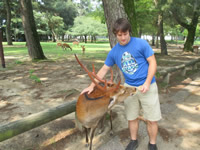
Interacting with the deer at Nara
Research Update
During the last week we were able to perform a few experiments, taking I-V curves, detection of THz radiation, and the FTIR. However, we have not yet been able to achieve any results that correspond with our theory. We intend to continue experimentation throughout this week and next week and hopefully we will be able to see some results soon. The limited supply of liquid Hydrogen, and the fact that we must share part of our experimental setup with another experiment, limits the amount of experimentation we are able to do.
I have finished my final draft of the abstract and had it approved by both of my advisors. Now I just have to complete the poster. I have done a large majority of the rough draft of my poster; I just lack the results and conclusions sections. However, I cannot complete these until we have gathered some more data. I intend to submit my rough draft for review in the next couple days so that I can gather some feedback and put together my final presentation.
Regrettably, this report will be quite short and difficult for me for a few reasons. At this time, we have not been able to arrange a meeting with all of our NanoJapan Buddies due to several conflicting issues. Deepika-san has been preparing for/taking her doctoral course entrance exams, Mastura-san works most evenings and has now left for the United States and will not be returning before we leave, Nana-san has been searching for a job in Tokyo, and Mika-san has been on a study abroad trip to Austria for the majority of our time here. Due to these circumstances, we have not managed to arrange a meeting; however, I have had some one-on-one conversations about some of these topics with the women in my lab.
Deepika-san is currently pursuing her Ph.D. here at Tohoku University, as an exchange student from India. Mastura-san is a second year Master’s student (MC2), who came to Japan from Malaysia about seven years ago to pursue higher education. Nana-san is a fourth year bachelor’s student (BC4) and is a Japanese native.
Until recently, it has been fairly uncommon for women to pursue the STEM fields. Lately, however, more women are working their way into science and engineering. Each of these girls, by simply pursuing their passions, is contributing to break the social stereotypes and norms regarding women in engineering, as all three of them are working toward degrees in Electrical Engineering. When asked why they chose engineering, their responses were plain and simple. They chose to pursue engineering because it is something that they all enjoy and has many practical applications, which can greatly improve our lives. Like many scientists, they too are curious and eager to learn, while also wanting to contribute something back to the world.
When asked about some of the difficulties they might have faced, they didn’t have much to say. They all agreed that the biggest issue was a sort of “identity crisis.” They stated that they felt somewhat afraid to ask questions during lectures, for fear of sounding “stupid.” Also, they sometimes notice that their ideas aren’t given as much credit or attention as some of the other student’s ideas, and that they are cut off from talking more often as well. However, they feel very welcomed here and really enjoy what they are doing.
As far as career path goes, they all have different ideas. Deepika-san is planning on pursuing her Ph.D. and entering into the world of academia. Mastura-san is doing what is more typical as an engineer in Japan and pursuing her Master’s degree, with the intention of entering the workforce afterward. Nana-san, however, is choosing to enter the workforce directly after her undergraduate degree, choosing not to pursue a higher degree at this time.
One thing that I know for sure is that each of these students has worked very hard to be where they are and that they are driven to succeed. They all agree that encouraging other women to pursue STEM fields is of utmost importance, and that there is a bright future for women in science.
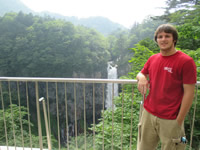
Admiring the beautiful Kegon no taki, a waterfall in Nikko
Ramya and I went paddle-boating in Chuzenji Lake in Nikko
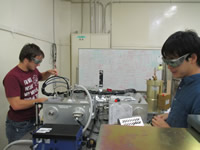
Doing Science”
Research Update
This week I have spent most of my time working on my poster and my presentation for the Tokyo symposium. I lack only two sections on my poster and I have finished with my Tokyo presentation, as of now.
This week we were able to do another set of experiments, taking I-V measurements and using the FTIR both under room temperature and cryogenic conditions. We had a problem with a leak in the vacuum chamber, however, and had to stop the measurements until we were able to fix the leak. Unfortunately this could not be done before we ran out of liquid nitrogen. The rest of the experimentation was postponed until Monday afternoon. Finally, we fixed the leak and re-ran the measurements. Unfortunately, we did not observe the peaks we expected on the I-V graphs. However, there was a team of researchers that published a paper earlier this year that said they did observe THz emission but were not able to observe NDC on the I-V curves, so we are hopeful that their results are correct. When we ran the FTIR, it produced some graphs that show that we may have attained some possible THz emission from the device under cryogenic conditions. We are reviewing the data tomorrow morning with Otsuji-sensei to clear it up for sure and to discuss further courses of action regarding experimentation.
For the rest of this week I will be working very hard on perfecting my poster for the final presentation at the RQI.
Coming later this summer!
Coming later this summer!